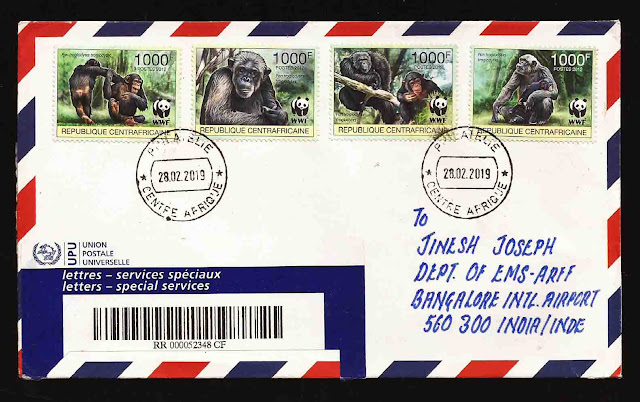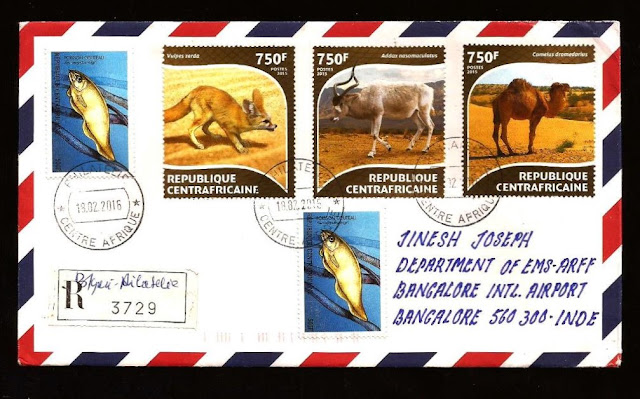The Central
African Republic (CAR; Sango: Ködörösêse tî
Bêafrîka; French: République centrafricaine ,
or Centrafrique
is a landlocked country in Central Africa. It is bordered by Chad
to the north,
Sudan to the northeast,
South Sudan to the southeast,
the Democratic Republic of the
Congo to the south, the Republic of the Congo to the southwest and Cameroon to the west.
The CAR covers a land area of about 620,000 square kilometres
(240,000 sq mi) and had an estimated population of around 4.7 million
as of 2018. As of 2020, the CAR is the scene of a civil war, ongoing since 2012.
The
Central African Republic is a landlocked nation within the interior of the
African continent. It is bordered by Cameroon, Chad, Sudan, South Sudan, the
Democratic Republic of the Congo, and the Republic of the Congo. In 2008,
Central African Republic was the world's least light pollution affected country. The Central African Republic
is the focal point of the Bangui Magnetic Anomaly,
one of the largest magnetic anomalies on Earth. In the southwest, the
Dzanga-Sangha National Park is located in a rain forest area. The country is
noted for its population of forest elephants and western lowland gorillas.
In the north, the Manovo-Gounda St
Floris National Park is well-populated with wildlife, including leopards, lions, cheetahs and rhinos, and the Bamingui-Bangoran National Park
is located in the northeast of CAR. The parks have been seriously affected by
the activities of poachers, particularly those from Sudan,
over the past two decades.
The Central African Republic
has been issuing stamps since 1959. Before this, it was called Ubangi-Shari. Ubangi-Shari (French: Oubangui-Chari) was a
French colony in central Africa which later became the independent country of
the Central African Republic
on August 13, 1960. It followed the establishment of the Bangui outpost in 1889, and was named in 1894.Military postal service began at Bangui in 1893, at
Fort Possel in 1894,
and was gradually extended along the Ubangi River and northwards into the country during the 1900s.
Civilian mail used postage stamps of Middle Congo (Moyen Congo) from 1907.
In 1915, Middle Congo stamps were overprinted "OUBANGUI-CHARI-TCHAD" for use in
Ubangi-Shari-Chad, and then in 1922 just "OUBANGUI-CHARI" after Chad
obtained its own stamps. In 1924, stamps were issued with the additional
overprint "AFRIQUE EQUATORIALE FRANCAISE". A number of those were
surcharged with new values between 1925 and 1927. In 1928, postage due stamps of France were overprinted "OUBANGUI-CHARI
/ A. E. F.", followed in 1930 by a set of 11 postage dues issued
specifically for the colony; printed in two colors, the lower values depicted a
landscape, and the higher values Émile Gentil.
A 1931 set of four stamps for the Colonial Exposition was
the last to be produced for the territory; from 1936 on, French Equatorial Africa
issues were used until 1959.
The
Republic became fully independent on 13 August 1960. From December 4, 1976 to
1979, the country was renamed the Central African Empire
when President Bokassa crowned himself emperor. It issued stamps labelled Empire
Centrafricaine in 1977. In 1979 the name of the country was restored to the
Central African Republic.
These two Registered covers sent by Martin from Bangui. The covers posted on October 10, 2016 and I received them on November 11, 2016.
The covers reached here safely but unfortunately the post office has no UPU barcode label in stock, so i am unlucky to get my favorite UPU label on Centrafricaine covers. The covers posted onFebruary 19, 2016 and received on March 27, 2016









No comments:
Post a Comment
Note: only a member of this blog may post a comment.